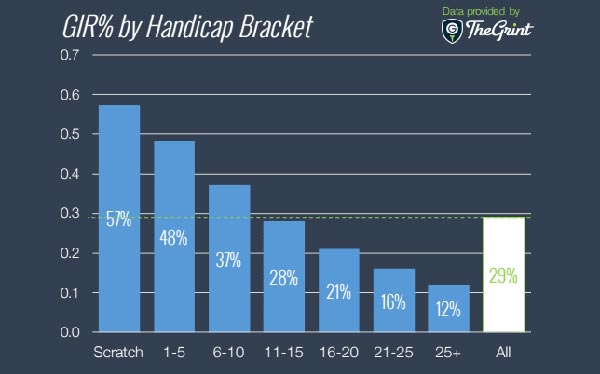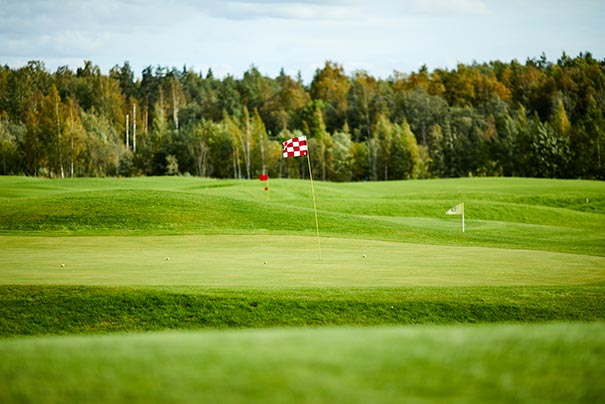A green in regulation (“GIR”) is when your ball reaches the green in two less strokes than the par for that hole. That means reaching the green in 1 shot on a par 3, two shots on a par 4, and three shots on a par 5. Reaching the green in regulation means you have two putts to make par.
Along with number of putts and fairways hit, this is one of the most common stats that golfers keep track of. But most golfers underestimate just how significant improving your greens in regulation are for lowering your score.
But a GIR doesn’t tell the whole story…
Happiness is a long walk with a putter.
– Greg Norman
Why Greens In Regulation Are Important For Amateur Golfers
Improving greens in regulation is the fastest and most effective way to lower your scores.
Of course, that is a little bit of an oversimplification of things because hitting a green in regulation incorporates a number of different aspects of your game. But in general, hit more GIR means lower scores.
According to this article on golf.com, you should hit about 6-13 GIR to be a single-digit handicap. That’s a pretty broad range but I think that trying to get to at least 7 GIR per round is a great goal for anyone that wants to get to that single-digit handicap. This is also a good target if you are working on breaking 80.
In general, greens in regulation tend to be the one stat that has the most direct correlation with score and handicap.
Take a look at the chart below that shows greens in regulation vs. handicap.

As you can see there is a direct correlation between average GIR and handicap.
But you’re probably thinking that just looking at GIR fails to take into consideration things like short game skills. Surely, if you work on putting and short game like crazy, then you can overcome an inability to hit more GIR.
Well, the stats don’t really bear that out. Although, there are always exceptions.
But let’s think about that logically. Missing an up and down from off the green and making bogey is the same on the scorecard as a three-putt. Do you 3 putt more often than you miss up and downs? Not likely.
In order for your short game to “make up” for missing GIRs, then your up and down percentage would have to be higher than the percentage of time you get a 2 putt or better. Most (almost all?) average golfers are MUCH better at two putting than they are at getting up and down from off the green.
Not to mention that as your up and down percentage improves, you’re probably getting better at putting so you’ll three-putt less too.
So, no matter how good your short game is, hitting the green is always going to have a bigger impact on your score.
I’m not saying not to work on your short game. But pitching, chipping, and putting will have a smaller effect on your score than improving your GIR percentage.
There is one more nuance to this whole thing though…
GIR alone can be somewhat of an imprecise stat.
Why is that?
Well, because GIR is an all-or-nothing stat. You either get the GIR or you don’t. It treats an approach shot that lands 10 feet from the hole but on the fringe the same as an approach that ends up in the water.
There is a way to add more accuracy to your stat tracking and I’ll talk about that a little further down, but now let’s talk about how you can get on the green a little more often.
How You Can Hit More Greens In Regulation
You’re probably thinking, yeah I know its important but if I could hit a green anytime I wanted, I wouldn’t be reading this.
Good point, so let’s talk about some ways you can get more GIRs with the swing you have today.
For most amateur golfers, scoring better is more about minimizing mistakes and not so much about hitting great shots.
Keep The Ball In Play
The fastest way to prevent reaching the green in regulation on a par 4 or a par 5 is with a wild tee shot.
Hitting the ball farther down the fairway does increase your chance of getting on the green, but ending up in the water, out of bounds, or behind a tree will instantly reduce that chance to 0%.
That doesn’t mean you need to lay up on every par 4 or par 5, but think about putting yourself in the best position for the next shot and avoiding the danger areas. For many golfers, playing an entire round without a penalty stroke off the tee would have a substantial effect on their score.
NOTE: This doesn’t mean you should be hitting a 6 iron off of every tee just to keep in on the fairway. Even for amateur golfers, the stats seem to show that hitting it far off the tee has a big effect on score IF you just keep it in play. Fairway vs. rough matters very little on most public and country club courses. So as long as you’re not playing in U.S. Open rough, hit it as far as you can while also keeping the ball away from positions that prevent you from having any shot at the green (yeah I know, easier said than done).

Maximize Approach Shot Success Rate
So we already know that just getting on the green is going to give you a better chance at making par than off the green.
So priority #1 on every approach shot should be to get on the green no matter what.
If the pin is in a big section of the green and not near any hazards, then, by all means, go for it.
But know your own abilities and read the situation. Aiming for a pin from 185 yards is very different than aiming at a pin from 95 yards.
Almost all amateur golfers, even low handicaps would benefit from aiming at the center of the green (or the biggest part of the green with the least trouble nearby).
Higher handicappers should play for the yardage to the back of the green because almost all golfers that aren’t breaking 80 consistently miss short much more often than long. So aiming for the back of the green will increase your percentages of getting on the green.
Taming Par 5s
Most golfers see “Par 5” and instinctively reach for their driver. But that may not always be the right play.
If you can easily reach the green in 2 shots and there’s not much trouble in the fairway, then sure, go for it. I am certainly not opposed to having fun on the course and the potential of an eagle putt is exciting. In fact, if you have a realistic shot of reaching in 2, then safely maximizing your distance will improve your percentages of scoring lower on average.
But more often than not for most amateur golfers, hitting 2 conservative shots will put you in a better position to hit the green on that third shot, especially if you have no chance at hitting the green in 2 shots and/or the fairway has some hazards ready to reduce your GIR chances to zero.
Short Par 4s
The short par 4 is golf’s version of the $20 bill on a string. You can’t resist reaching for it but you usually end up looking silly.
I’d suggest the same strategy here that you would apply to a par 5. If you can easily reach the green in 1 shot and there’s not a lot of trouble around the green that would reduce your chances of a GIR to zero, then go for it.
But if you need to hit a drive 10 yards past your all-time longest, then maybe back off, and hit a club that will leave you a comfortable yardage.
Develop A Comfortable Layup Yardage
Having a yardage that you know you can hit with high consistency can be a huge help for hitting more greens in regulation.
For me, it’s 105 yards with a 54 degree wedge. I practice it often and feel most comfortable at that yardage. So when I apply the par 5 and short par 4 strategies above, this is what I’m aiming for if I lay up.
This is going to be different for everyone, so find out what your go to yardage is and play your round accordingly.
To work on dialing in your distances, a personal launch monitor can be very helpful.
GIR Is Less Important For Elite Players
Don’t look at PGA Tour pro stats as an indicator of what you should be working on. For them, things like proximity to the hole is much more important than GIR simply because they can get up and down for par at a very high percentage and they need to be close enough to make lots of birdies to compete for wins.
You, on the other hand, need to be thinking about making pars and avoiding double bogeys, so just getting on the green consistently is a LOT more important for you.
Tracking GIR For Amateurs
Now let’s talk about getting some useful stats for your own game.
Technically speaking, a shot that lands on the fringe is not a GIR. But in terms of being an indicator of your score, its virtually the same so long as you are treating it as you would any other putt on the green. This is the simplest solution to the “all or nothing” problem with using GIR as a goal in your game.
So you can use a little of your own judgment on this since whether you count it as a GIR has no effect on your score or handicap.
That doesn’t mean it counts as a GIR if you decide to putt from 10 yards off the green. But a 15 foot putt from the collar is not really any more difficult than a 15 foot putt from the middle of the green.
If you’re looking for the ideal way to track your approach shots then using “strokes gained” is a much more accurate measure. However, it involves a lot more than just marking a yes or no on your scorecard.
The strokes gained statistic takes into consideration the proximity to the hole for each shot as well as some other factors and measures whether you gained or lost strokes compared to other golfers. The result is usually given in terms of fractions of a stroke.
So obviously, this isn’t something that you can track yourself.
My solution for this is to use a shot tracker. There are a lot of options out there and if you want to read about my favorite one check out my Arccos Caddie review. I’ve been using this for about 10 months now and it has let me keep track of everything while still focusing on playing my shots.
Don’t Ignore Putting
The easiest way to ruin a green in regulation is to three-putt for a bogey. So eliminating three-putts goes hand in hand with hitting more GIR.
The good news is that you don’t need to be a lights-out putter. Being smart about your first putt and focusing on getting it to tap in range is a lot easier than making 12 footers for par after you missed the green.
